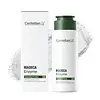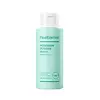What's inside
What's inside
 Key Ingredients
Key Ingredients

 Benefits
Benefits

 Concerns
Concerns

No concerns
 Ingredients Side-by-side
Ingredients Side-by-side

Zea Mays Starch
AbsorbentSodium Cocoyl Isethionate
CleansingSodium Lauroyl Glutamate
Sodium Lauroyl Aspartate
CleansingGlucose
HumectantMentha Arvensis Powder
MaskingAllantoin
Skin ConditioningWater
Skin ConditioningPapain
Skin ConditioningLactobionic Acid
BufferingButylene Glycol
HumectantRosmarinus Officinalis Leaf Extract
AntimicrobialSaponaria Officinalis Leaf/Root Extract
Skin ConditioningSalix Alba Bark Extract
AstringentLipase
Skin ConditioningAsiaticoside
AntioxidantMadecassic Acid
Skin ConditioningAsiatic Acid
Skin ConditioningCentella Asiatica Extract
Cleansing1,2-Hexanediol
Skin ConditioningGlycerin
HumectantHydroxyacetophenone
AntioxidantProtease
ExfoliatingEthylhexylglycerin
Skin ConditioningHydrolyzed Hyaluronic Acid
HumectantZea Mays Starch, Sodium Cocoyl Isethionate, Sodium Lauroyl Glutamate, Sodium Lauroyl Aspartate, Glucose, Mentha Arvensis Powder, Allantoin, Water, Papain, Lactobionic Acid, Butylene Glycol, Rosmarinus Officinalis Leaf Extract, Saponaria Officinalis Leaf/Root Extract, Salix Alba Bark Extract, Lipase, Asiaticoside, Madecassic Acid, Asiatic Acid, Centella Asiatica Extract, 1,2-Hexanediol, Glycerin, Hydroxyacetophenone, Protease, Ethylhexylglycerin, Hydrolyzed Hyaluronic Acid
Zea Mays Starch
AbsorbentSodium Cocoyl Isethionate
CleansingSodium Lauroyl Glutamate
Diglycerin
HumectantAllantoin
Skin ConditioningMaltodextrin
AbsorbentPapain
Skin ConditioningWater
Skin ConditioningProtease
Exfoliating1,2-Hexanediol
Skin ConditioningGluconolactone
Skin ConditioningSalicylic Acid
MaskingCitric Acid
BufferingCapryloyl Salicylic Acid
ExfoliatingGlyceryl Glucoside
HumectantGlycerin
HumectantMyristoyl/Palmitoyl Oxostearamide/Arachamide Mea
Skin ConditioningCeramide NP
Skin ConditioningMadecassoside
AntioxidantZea Mays Starch, Sodium Cocoyl Isethionate, Sodium Lauroyl Glutamate, Diglycerin, Allantoin, Maltodextrin, Papain, Water, Protease, 1,2-Hexanediol, Gluconolactone, Salicylic Acid, Citric Acid, Capryloyl Salicylic Acid, Glyceryl Glucoside, Glycerin, Myristoyl/Palmitoyl Oxostearamide/Arachamide Mea, Ceramide NP, Madecassoside
Ingredients Explained
These ingredients are found in both products.
Ingredients higher up in an ingredient list are typically present in a larger amount.
1,2-Hexanediol is a synthetic liquid and another multi-functional powerhouse.
It is a:
- Humectant, drawing moisture into the skin
- Emollient, helping to soften skin
- Solvent, dispersing and stabilizing formulas
- Preservative booster, enhancing the antimicrobial activity of other preservatives
Allantoin is a soothing ingredient known for its protective and moisturizingg properties. Because of this, it is often added to products with strong active ingredients.
Studies show higher concentrations of this ingredient can promote wound healing.
Though it can be derived from the comfrey plant, allantoin is produced synthetically for cosmetic products to ensure purity.
Learn more about AllantoinGlycerin is already naturally found in your skin. It helps moisturize and protect your skin.
A study from 2016 found glycerin to be more effective as a humectant than AHAs and hyaluronic acid.
As a humectant, it helps the skin stay hydrated by pulling moisture to your skin. The low molecular weight of glycerin allows it to pull moisture into the deeper layers of your skin.
Hydrated skin improves your skin barrier; Your skin barrier helps protect against irritants and bacteria.
Glycerin has also been found to have antimicrobial and antiviral properties. Due to these properties, glycerin is often used in wound and burn treatments.
In cosmetics, glycerin is usually derived from plants such as soybean or palm. However, it can also be sourced from animals, such as tallow or animal fat.
This ingredient is organic, colorless, odorless, and non-toxic.
Glycerin is the name for this ingredient in American English. British English uses Glycerol/Glycerine.
Learn more about GlycerinPapain is an enzyme found naturally in the papaya plant's leaves, fruit, and roots. It has antimicrobial, soothing, and wound healing properties.
Glycine and Vitamin A are naturally found in papain.
While papain is often touted as skin-lightening, further studies are needed to prove this. However, papain has been shown to help soothe acne-inflammation.
Papain belongs to a class of enzymes called proteolytic enzymes. These enzymes break down peptides and amino acids.
Some studies found papain to be a potential skin sensitizer and allergen. Those with latex allergies might also be allergic to papaya.
Learn more about PapainThese enzymes break down protein into smaller peptides and amino acids. They also encourage the formation of new protein.
Our skin uses peptides, amino acids, and protein for maintaining healthy skin cells.
Protease work by breaking peptide bonds in protein with hydrolysis. This is the process of breaking bonds using water.
An in-vitro study (not done on a living organism) found a blend of 3-protease decreases skin inflammation by mitigating the effects of other proteins.
One manufacturer that uses subtilisin, a protease from Bacillus subtilis, claims this ingredient is exfoliating, promotes cell regeneration, and is a good substitute for AHAs. Further research is needed to back up these claims.
Fun fact: The human body contains ~641 protease genes.
Learn more about ProteaseSodium cocoyl isethionate is a natural ingredient from coconut oil. It is an ultra gentle cleanser that gives a nice foam without drying the skin or impacting the skin barrier.
The amount of foam created depends on the amount of sodium cocoyl isethionate used in the product.
This ingredient also helps improve the spreadability of a product.
Learn more about Sodium Cocoyl IsethionateSodium Lauroyl Glutamate is the sodium salt from the lauric acid of glutamic acid.
It is a surfactant and helps cleanse the skin. Surfactants gather oil, dirt, and other pollutants from your skin so they may be washed away easily.
Water. It's the most common cosmetic ingredient of all. You'll usually see it at the top of ingredient lists, meaning that it makes up the largest part of the product.
So why is it so popular? Water most often acts as a solvent - this means that it helps dissolve other ingredients into the formulation.
You'll also recognize water as that liquid we all need to stay alive. If you see this, drink a glass of water. Stay hydrated!
Learn more about WaterZea Mays Starch is starch made from corn. You might know this as cornstarch . It is used to thicken a product. It can replace talc as an absorbent.
The pH of cornstarch is 5.92.
Cornstarch is a common food ingredient used to thicken soups or to make corn syrup.
Learn more about Zea Mays Starch